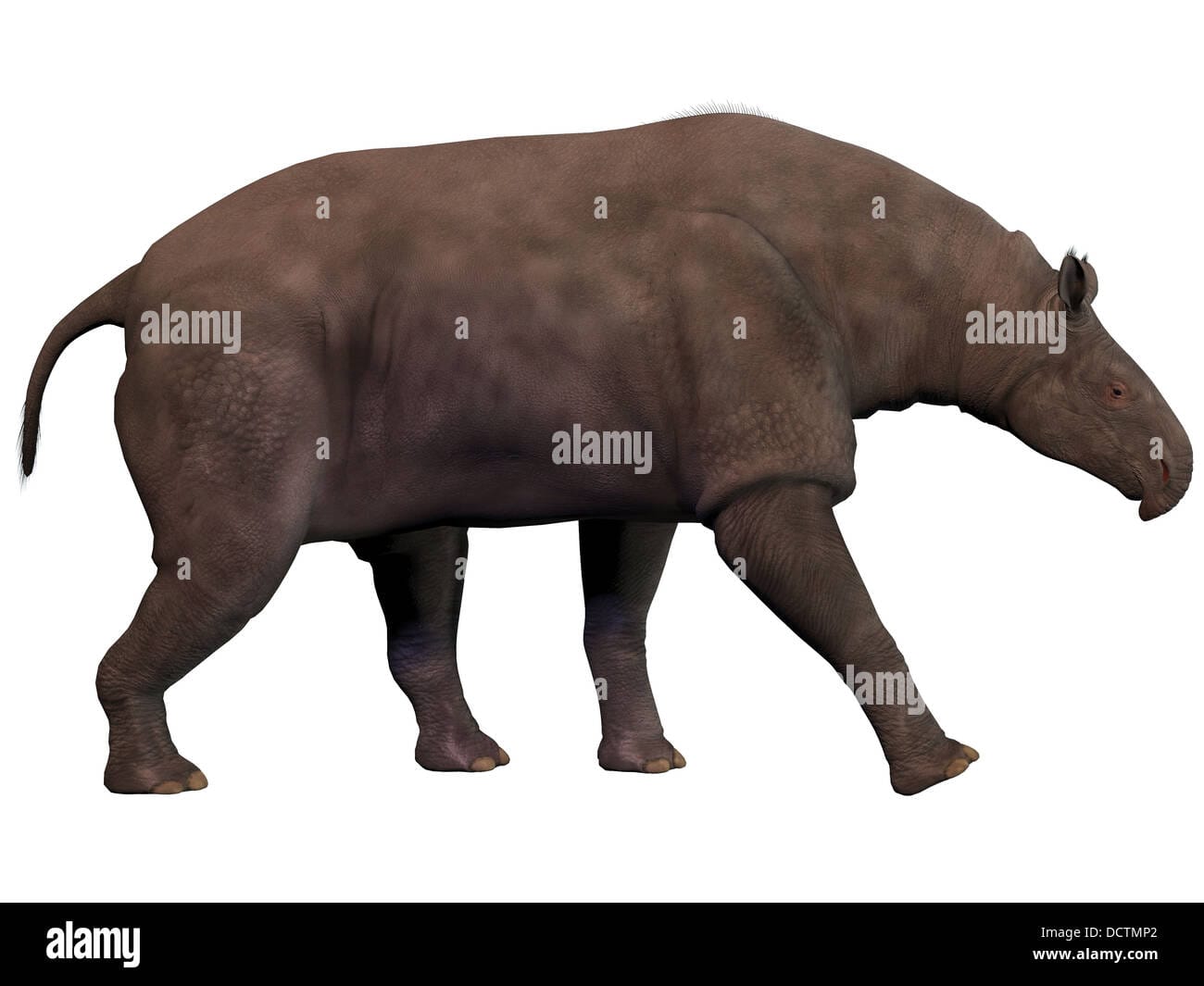A Gentle Giant of the Oligocene
Imagine a creature so large, it dwarfed even the largest elephants alive today. This wasn’t some mythical beast from a fantasy novel; this was Baluchitherium, a real-life giant that roamed the earth millions of years ago. Let’s embark on a journey back in time to unravel the mysteries of this incredible animal, often referred to as the “Beast of Balochistan,” and understand how such a titan could vanish from existence.
Baluchitherium was a type of rhinoceros, though you wouldn’t mistake it for the ones we know today. This behemoth lived during the Oligocene epoch, roughly 34 to 23 million years ago—millions of years after the dinosaurs went extinct!
One look at this creature and you’d know it was special. Picture a rhinoceros without a horn, then supersize it to be taller than a giraffe—that’s Baluchitherium in a nutshell. Its long neck wasn’t just for show; it allowed this gentle giant to reach high up into the trees and feast on leaves that other herbivores could only dream of.
Interestingly, scientists initially had a bit of a naming mishap with Baluchitherium. Some called it Indricotherium, while others preferred Paraceratherium. It took a while for them to realize they were all talking about the same incredible animal!
Now, you might think being big is always an advantage, but it can also come with its challenges. Keeping cool, for example, could have been a real struggle for Baluchitherium. Imagine trying to regulate your body temperature when you’re that enormous!
A Global Giant’s Decline
Fossils of Baluchitherium have been unearthed across a vast area, from the eastern reaches of Europe all the way to China. This suggests they weren’t picky eaters and could adapt to a variety of environments. However, even giants aren’t invincible.
About 11 million years after their arrival, Baluchitherium vanished from the Earth. The exact reasons for their extinction remain a puzzle, but scientists have some compelling theories. Changes in climate could have disrupted their food sources, while competition from other herbivores might have made it harder for them to thrive.
The story of Baluchitherium isn’t just about a bygone era; it’s a reminder of the incredible diversity of life that has existed on our planet and the constant changes that have shaped its course. While Baluchitherium may be long gone, its legacy lives on, captivating our imaginations and reminding us of the power of nature’s grand designs.
Exploring the Giant: Was It a Dinosaur?
We’ve established that Baluchitherium was massive, a true titan among creatures. But this begs the question – was this giant a dinosaur? The answer, in short, is no. While its immense size might make you think of those prehistoric behemoths, Baluchitherium actually belonged to a different branch of the animal kingdom altogether – the mammals.
Think of it this way: if dinosaurs were on one side of a giant family tree, Baluchitherium would be way over on another branch, hanging out with the mammals. You see, Baluchitherium roamed the Earth millions of years after the dinosaurs went extinct. It was part of a group called Perissodactyla, which includes animals we know and love today—horses, rhinos, and tapirs.
What Made Baluchitherium Different?
For starters, its appearance was completely different from any dinosaur. Imagine a creature that dwarfed elephants, with a head like a rhino (but without the horn!) and legs so long they could reach the top of small trees. That’s our Baluchitherium, a gentle giant that munched on leaves high in the treetops.
Let’s break down the key differences:
Physical Features: Dinosaurs, with their scales, sharp teeth, and tails dragging on the ground, looked nothing like Baluchitherium. Our friend had fur, likely for warmth and protection, just like many mammals today.
Timeline: This is a big one! Dinosaurs disappeared around 66 million years ago. Baluchitherium, on the other hand, lived much later, during a period called the Oligocene epoch, roughly 34 to 23 million years ago. This alone tells us they were on completely different evolutionary paths.
Mammalian Traits: Here’s the clincher: Baluchitherium shared characteristics with mammals that dinosaurs simply didn’t have. It gave birth to live young, unlike dinosaurs who laid eggs.
Unraveling the Mysteries of Baluchitherium
Even though we’ve learned a lot about this amazing creature, there’s still much we don’t know. How did it grow to be so massive? What exactly did it eat? Did it live in herds, or was it a solitary creature?
Scientists are still searching for answers to these questions. Every new fossil discovered adds another piece to the puzzle, bringing us closer to understanding the life and times of Baluchitherium.
In Conclusion
Baluchitherium, the giant that wasn’t a dinosaur, continues to capture our imaginations. While it might not have been a dinosaur, it was undoubtedly a remarkable animal. Its story reminds us of the incredible diversity of life on Earth and the mysteries that scientists are still working to unravel.
Deciphering a Name: What Does Baluchitherium Mean?
We’ve been talking about this awesome creature, the Baluchitherium, but have you ever wondered what its name actually means? It’s like a puzzle made up of two parts. The first part, “Baluchi,” points us straight to where the very first fossils of this giant were unearthed: Balochistan, a region nestled in present-day Pakistan. Makes sense, right? They found it there, they named it after there. The second part, “therium,” is a bit fancier. It comes from Greek and basically translates to “beast.” So, put them together, and you get “Beast of Balochistan”! It’s a pretty fitting name when you think about it – this Baluchitherium wasn’t just any animal; it was colossal, a true giant of its time that roamed Central Asia.
The Beast of Balochistan: A Closer Look
Imagine an animal even bigger than an elephant, like something out of a fantasy novel! That’s what Baluchitherium was – a real-life giant that roamed the earth millions of years ago. This massive creature, nicknamed the “Beast of Baluchistan” after where its bones were first discovered, wasn’t a dinosaur, but a type of ancient rhinoceros… only much, much larger. We’re talking seriously huge, like towering-over-everything-else huge! From nose to tail, this behemoth could stretch over 25 feet long, and when it stood up on its sturdy legs, it could reach heights of around 18 feet, enough to peek into a second-story window!
Now, despite its imposing size, Baluchitherium was likely a gentle giant, content to munch on leaves and twigs. Its long neck, similar to a giraffe’s, allowed it to reach high up into the trees, where it would graze on foliage that other animals couldn’t. Imagine this enormous creature lumbering through the prehistoric landscape, its long neck swaying as it stripped branches bare – quite a sight!
But like all good things, Baluchitherium’s time eventually came to an end. The why and how of their disappearance is still a puzzle that scientists are trying to piece together. Some believe that changes in the climate, perhaps making it harder to find food, might have played a part. Others suggest that new types of animals emerged, competing with Baluchitherium for resources. It’s even possible that both these factors, and maybe others we haven’t discovered yet, combined to drive these gentle giants to extinction.
The story of Baluchitherium is a fascinating reminder of the incredible diversity of life that has existed on our planet. Although this colossal creature is long gone, its fossils continue to spark our imagination and fuel our curiosity about the prehistoric world. Each new discovery brings us closer to understanding the life, behavior, and ultimate fate of the “Beast of Balochistan,” a true marvel of evolution.
Seeking insights into the enigmatic Bermuda Triangle German bunkers? Delve into our comprehensive exploration to uncover the intriguing connection between these enigmatic structures and the infamous triangle.
If you’re fascinated by the colossal size of the bear steepener, our in-depth analysis will unravel the remarkable characteristics of this prehistoric titan.
















